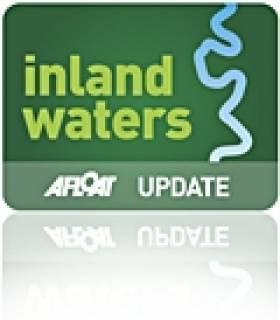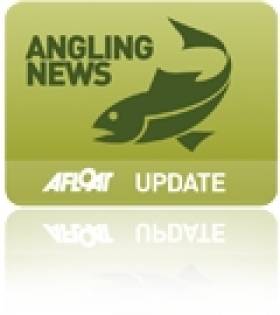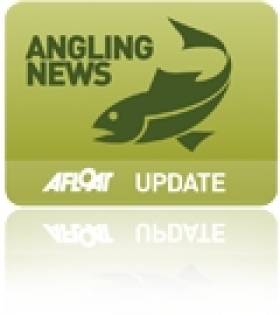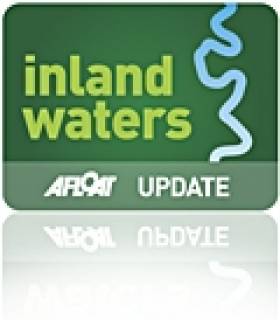Displaying items by tag: inland waterways
Waterways Ireland CEO John Martin's Achievements
#inland waterways – John Martin, Chief Executive of Waterways Ireland, was due to retire in March 2013, but is staying on until his successor arrives. This is an opportune moment to look at his achievements.
The definition of Irish waterways has been altered several times since the end of commercial carrying about fifty years ago. They ceased to be part of a transport system but the structures still needed to be maintained, so waterways became an engineering activity, with a side order of tourism. Then Michael D Higgins seized both the initiative and the waterways, shifting them to the Heritage Service.
But the prospect of Peace In Our Time brought about a further redefinition in 1999. The assignment of waterways to a new Cross-Border Implementation Body, under the Good Friday Agreement, could be seen as anything from a step towards a united Ireland (to be welcomed or resisted depending on your politics) to a "sensible rationalisation of a waterways network" [Coakley et al 2006]. That network was now explicitly stated to be primarily for recreational purposes, and it was to be managed by a new cross-border "body".
Setting up a new organisation is not an easy task at any time. It's much harder when the context is so new, and the politics so delicate, that the organisation can't be described as anything more specific than a "body"; when you have to merge staff from large and small organisations; when you're operating across national boundaries with two legal systems, two currencies and two sets of employment law; when you have to add new functions like accounting and marketing.
Waterways Ireland has done all of that, and done it against an intensely political background, where the organisation's very existence is a political statement. It has reported to ministers in two jurisdictions, ministers whose positions may vary with the political affiliation of the incumbent. That is in addition to the usual pressures from politicians anxious to promote their own pet projects (or those of their supporters) and to the possible problems of operating in constituencies with very different political complexions.
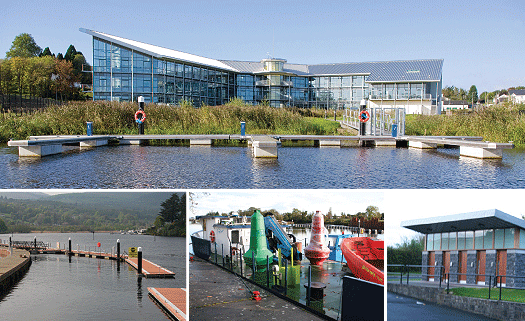
Main image: Waterways Ireland HQ at Enniskillen (courtesy Waterways Ireland), From left: New moorings and walkway at Killaloe, Inis Cealtra with buoys in Tarmonbarry, Service block at Enfield on the Royal Canal.
There have been some problems, but fewer than might have been predicted. In a context where mere survival might have been an achievement, Waterways Ireland has gone well beyond that. It was, admittedly, lucky in being able to take advantage of the late Celtic Tiger, but it made good use of the funding. The waterways are probably better equipped now than at any time since the Shannon Commissioners ceased their work, with excellent infrastructure, user facilities and capital equipment — as well as a splendid headquarters building in Enniskillen.
Perhaps more importantly, WI has brought about its own redefinition of the waterways. It has widened the range of recreational activities and drawn attention to that range. It has succeeded in attaching its own identity to the waterways, making it clear that they are managed entities, and it is now exerting control over certain areas where laxity has been the norm.
All of this adds up to a tremendous achievement. It has required work from the civil servants in the two Government departments, north and south, and the staff of the North-South Ministerial Council, as well as from politicians in both jurisdictions, but above all it reflects the hard work of the staff of Waterways Ireland, the senior management and, in particular, the retiring Chief Executive, John Martin. He has had the thanks and good wishes of politicians on all sides in the Northern Ireland Assembly and he deserves the same from all waterways users.
New Salmon & Sea Trout Bylaw for River Suir
#Angling - Recreational angling on the River Suir is set for a change as a new bylaw sought by a majority of anglers has been signed into law.
As of Friday 12 April till the end of the season, when fishing for salmon and sea trout (over 40cm) on the River Suir, the use of worms, prawn, shrimp or any other crustacean or artificial forms thereof as bait is prohibited - as is the use of any fish hooks other than single barbless hooks, up to and including 11 May.
From 12 May to 30 September the bylaw provides for a bag limit of five fish for the season subject to a daily bag limit of one fish. Anglers must use a single barbless hook once their daily or season bag limit has been reached.
Inland Fisheries Ireland (IFI) points out that this bylaw is applicable to the 2013 season only.
It is hoped that this measure will ensure even better angling for the many local anglers and angling tourists that come to fish the Suir for brown trout from Tipperary to Waterford.
Entries Open For IUSRU Raft Race at Docklands Summer Fest
#InlandWaterways - The Irish Underwater Search and Recovery Unit (IUSRU) has announced details of its Raft Race as part of the Waterways Ireland Docklands Summer Festival.
Entry is €25 per person with four persons per raft for the day of wackiness on the water at Grand Canal Basin on 19 May.
And for those who can't build their own raft in time, prebuilt rafts can be supplied by the organisers.
More details of the event can be had from the IUSRU at 087 975 8656 or [email protected].
The complete programme of events for the Docklands Summer Festival will be posted on the official website shortly.
Protection of Breeding Birds at Bushy Island, Lough Derg
#breedingbirds – Waterways Ireland has been advised that protected birds are present and breeding on Bushy Island, Lough Derg.
To protect and minimise disturbance to nesting birds in the area, Masters of vessels are requested to observe a voluntary exclusion zone by not encroaching within 250m of the island and to proceed directly in and out of the harbour without stopping near the island, particularly between the months of April and August inclusive.
Masters should note that deliberate disturbance to nesting birds is illegal under the Wildlife Act (1976).
Rent & Navigate Your Own Canal Barge Through Dublin City
#dublinbarge – After one hour personal instruction on how to drive, moor and navigate a barge through a lock, you can drive your very own barge in Dublin city centre.
The barge 'Scéal Eile' is a new and exciting form of accommodation offered at Grand Canal Dock, Dublin 2.
Dublin Barge Hire is Dublin city centre's first self-catering cruising barge.
Not only is this an exclusive and unique place to stay, the barge is a form of transport as well.
Guests will have access to the secure and serviced Marina in Grand canal Dock and from here you can navigate through seven locks up to Portobello.
It is a four hour round trip along an historic stretch of canal, originally opened in 1796.
The barge has a capacity of 4 adults and 2 children. For two nights based on two people sharing the package is priced at €300.
'Scéal Eile', a 50 x 10 foot (15 x 3.1 m) barge was built in 2006 to a high specification according to its owners. They say the barge has a warm inviting interior and a comfortable living space that makes this self-catering barge an environment for a holiday break.
It contains a multi-fuel stove with a back boiler which makes a stay on the barge during winter a cosy experience.
More on www.dublinbargehire.com
#Angling - Minister Fergus O'Dowd launched Ireland’s first purpose-built disinfection station for angling enthusiasts at Ballyhoe Lake in Co Cavan on Wednesday 3 April.
The new facility - developed by Inland Fisheries Ireland (IFI) in co-operation with Interreg IVA (CIRB), the Irish Angling Development Alliance (IADA) and the local Meathhill Angling Club - will facilitate the disinfection of angling equipment on entry to the lake, helping to ensure that unwanted alien invasive species and harmful fish pathogens can be kept out of our natural fisheries.
Moreover, the development will also provide a template for further such facilities on fishery watercourses throughout the country.
The disinfection station is located at the entrance to Ballyhoe Lake, a prime Irish specimen tench fishery.
The entrance gate and the disinfection station are secured with combination locks, the numbers for which are available through nominated members of the Meathhill Angling Club (contact numbers for these members are provided on the tank). Members of the club will replace the disinfectant and manage the facility locally, as necessary.
Once opened, the tank contains a disinfection container for boots, keep nets, landing nets and stink bags. Disposable gloves are provided for angler use while disinfecting, and a brush is available to scrub boots, as well as a spray bottle for boats coming onto the lake.
Signage adjacent to and underneath the lid of the tank provides step-by-step instructions for the angler. Once the gear has been disinfected, the anglers apply a tag to his or her net to show that the process has been completed. Different colour tags will be utilised at the discretion of the operators.
Congratulating Meathhill Angling Club and the IADA at the launch, Minister O'Dowd said: "Angling clubs and federations the length and breadth of Ireland are key to the protection of our angling resources. By providing facilities such as this, we are adding to the goodwill and community commitment of Meathhill Angling Club to protect their fishery, while also ensuring access to it.
"This access helps to safeguard the sustainability of our valuable resource which will continue to bring much needed revenue to the local community through responsible angling activity."
The minister added that he "can’t emphasise enough the role anglers and clubs have on the frontline in the fight against invasive species, which supplements the great work in the area carried out by IFI with the support of representative bodies such as IADA."
Young Dublin Angler Catches Record Trout At Lough Ramor
#Angling - A new record has been set by the Dublin Angling Initiative with 16-year-old Eric Cahill catching a fish of a lifetime - a 12lb ferox trout from Lough Ramor in Virginia, Co Cavan.
This is the biggest fish ever caught by a youngster out angling with the Dublin Angling Initiative (DAI).
The fishing trip for a group of 10 young anglers was organised for Mulhuddart Foróige Fishing to Lough Ramor by Des Chew of the DAI in March.
Following an introduction by Des on the setting up of rods, rigs and bait presentation, the youngsters were soon fishing for roach, hybrids and perch with others choosing to fish for pike.
Great fun was being had by the group who were catching and releasing lots of coarse fish.
Meanwhile, Eric patiently waited for a pike to take his smelt deadbait. He signalled for assistance when his rod tip nodded indicating a take. Under the guidance of Des Chew and Chris McGregor, he was instructed to knock his bale arm over so this cagey fish would feel no resistance.
Suddenly there was a short run and Eric struck. It was obvious he had a big fish on. When the fish drew close, the golden-spotted body revealed that Eric was now playing a fish of a lifetime and maybe the first specimen caught by a DAI angler.
The fish was landed amid great excitement by the kids, youth workers and a crowd of local anglers alike.
Before release it was weighed on certified scales, and laid out and measured on an Inland Fisheries Ireland measuring mat. It reached a length of over 80cm and weighed in at over 12 lbs.
There was jubilation among Eric and his peers as Des announced that he had just caught the first specimen from over 10,000 teenagers who have participated in DAI courses over the last 15 years.
If this fish is ratified by the Irish Specimen Fish Committee it will also be the first specimen recorded from Lough Ramor.
Eric Cahill has been a member of Mulhuddart Foróige Fishing in west Dublin since he has been 10 years of age. During that time the DAI says he has always shown unique ability to listen and learn angling skills from his tutors.
He has attended numerous fishing courses in game, coarse and sea fishing run by the DAI with his Foróige youth officers, Bernie Moloney and Siobhan Hennessy.
According to Inland Fisheries Ireland, this was truly a very proud moment for Eric and the Dublin Angling Initiative, whose members now have a new record to beat!
Limerick Salmon Anglers Hail Net Fishing Ban On River Feale
#Angling - The battle to stem the decline of salmon stocks in Ireland's inland waterways has taken a step forward in Limerick with the news that net fishing on the River Feale will be banned from the end of July.
As the Limerick Leader reports, the end of licensed net fishing on the Feale - and important salmon spawning watercourse that flows from the Mullaghareirk Mountains in Cork through Limerick and Kerry to the mouth of the Shannon - has been welcomed by local stakeholders as "a vital step towards restoring depleted fish stocks on the embattled river".
Salmon stocks in the Feale alone have reportedly collapsed by more than 10,000 in just six years.
Local angler Brendan Danagher said that the decision to ban net fishing would also encourage anglers to accept other restrictions for conservation on the river - which include a maximum catch of one fish per person per day, with a total of three catches allowed per individual till the end of the season.
“If they’re bringing in new bylaws, they must have the goodwill of anglers," he added.
The Limerick Leader has more on the story HERE.
Lock One Repairs Complete On Shannon-Erne Waterway
#InlandWaterways - Waterways Ireland advises masters and owners of vessels that repairs to the lock and gates at Lock 1 Corraquill on the Shannon-Erne Waterway in Co Fermanagh which began on 29 January have now been completed.
'Big Spring Clean' Underway In Fermanagh Waterway
#InlandWaterways - The Belfast Telegraph reports on the annual clean-up of the Glendarragh River in Co Fermanagh by local anglers determined to preserve the quality and natural beauty of their inland waterways resource.
The Kesh and District Angling Club's yearly Big Spring Clean anti-litter drives sees anglers and other volunteers boat along the watercourse to remove as much rubbish and discarded debris as they can find.
As the only waterway in the area where cruisers - many carrying tourists - can travel upstream from Lough Erne, the ugly sight of built-up litter reflects badly on the Fermanagh lakelands, according to club chair Stephen Hey.
"Over the years the water quality has been getting better, but from an aesthetic point of view it's terribly sad to come up the river on a boat and see a rubbish tip." he said, adding that suspected fly-tipping is the cause of much of the waste.
The Belfast Telegraph has more on the story HERE.































